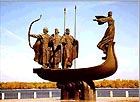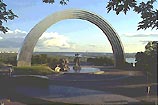History of Kiev

![[ About NAU ]](../b/nau.jpg)

 The history of Kyiv like that of any other large and ancient city begins with
a legend. Kyiv was founded by three brothers - Kiy, Shek and Khoriv - and their sister Lybid.
The history of Kyiv like that of any other large and ancient city begins with
a legend. Kyiv was founded by three brothers - Kiy, Shek and Khoriv - and their sister Lybid.
Like any other large and ancient city Kyiv is situated on hills. And there are seven of them, i. e. a number that fits in with a tale that is rather legendary than historical.
 A town, which is fifteen hundred years old, is likely to have architectural
landmarks of various architectural styles, which date to various epochs. And if such a town
is a capital of large state of long history and cultural traditions the likelihood of
seeing splendid palaces, elegant mansions and majestic churches increases considerably.
Location, territories, and communication facilities Kyiv, a scenic city of close to 3
million people situated on the Dnipro River, is the bustling capital of Ukraine. The town's
area amounts to 790 sq. kilometers.
A town, which is fifteen hundred years old, is likely to have architectural
landmarks of various architectural styles, which date to various epochs. And if such a town
is a capital of large state of long history and cultural traditions the likelihood of
seeing splendid palaces, elegant mansions and majestic churches increases considerably.
Location, territories, and communication facilities Kyiv, a scenic city of close to 3
million people situated on the Dnipro River, is the bustling capital of Ukraine. The town's
area amounts to 790 sq. kilometers.
Woods, parks and public gardens make up over half its area of nearly 80,000 hectares. Kyiv justly called one of the word's greenest cities. Kyiv is the largest industrial, scientific and cultural center of Ukraine as well as center of railroads and airways.
Archeological excavations show evidence of the first settlements on the territory of Kiev 15,000 to 20,000 years ago.
Kyiv was founded in 482 AD and grew into powerful center of medieval state
Kyivian Rus; the first state of Eastern Slavs which stretched from the Baltic to the Black
See. Throughout the 8th-12th centuries Kyiv was the capital of a huge Slavic state in
addition to being the leader of culture and Christianity in Eastern Europe. It contained
the largest library in the Christian world and through its royal marriages it enjoyed
relations with Europe's dynasties. Kyiv prospered as trade and cultural center and won a
measure of international recognition until the Mongols invaded it in the 13th century.
Kyiv manage to reestablish its leading role only at the end of 16th century when liberation
wars which were led by Cossacks began. After Ukraine fell under Russian protection it became
center of the Southern part of Russian Empire.
 By the end of the 18th century Kiev already
had a population of 30,000. This period saw the appearance of wooden buildings in the
Khreshchataya Valley (present-day Kreshchatik), between whose forest-covered slopes flowed a
small stream. Now the main street of city, Khreschatic, is wide and magnificent.
By the end of the 18th century Kiev already
had a population of 30,000. This period saw the appearance of wooden buildings in the
Khreshchataya Valley (present-day Kreshchatik), between whose forest-covered slopes flowed a
small stream. Now the main street of city, Khreschatic, is wide and magnificent.
During World War II, Kyiv was heavily damaged. The post war years in Kyiv were marked by intensive restoration of the damage caused during the war.
 Now Kyiv is a charming city of gardens and parks, with marvelous hills and
unique sightseeing. Having bunch of trees and flowers it is always associated with chestnuts.
Kyiv architectural landscape is unique. Due to the huge number of orthodox churches it is
called sometimes the Gold-Domed City.
Now Kyiv is a charming city of gardens and parks, with marvelous hills and
unique sightseeing. Having bunch of trees and flowers it is always associated with chestnuts.
Kyiv architectural landscape is unique. Due to the huge number of orthodox churches it is
called sometimes the Gold-Domed City.
Kyiv is beautiful at any seasons of the year, and if you are fortunate enough to come at the time when the trees on its streets are green, when the carpets of flowers are radiant with all colors of the rainbow, the city will produce an ineffaceable impression.
![[ Rector NAU ]](../b/rector.jpg)

![[ About Kiev ]](../b/kiev.jpg)